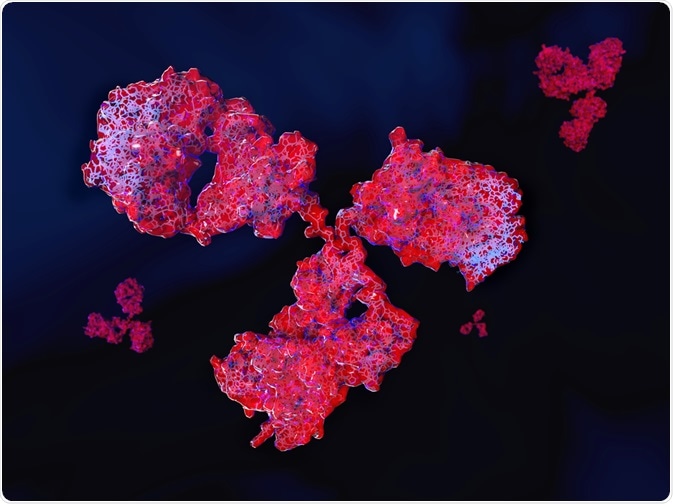The protein A/G purification method is used to purify monoclonal IgA and IgG antibodies using a recombinant of Protein A and Protein G – also known as Protein A/G.
 Juan Gaertner | Shutterstock
Juan Gaertner | Shutterstock
Affinity purification of antibodies
Previous purification methods, such as ammonium sulphate precipitation, were known to yield a crude purification of proteins. Affinity purification of antibodies is one of widely used techniques where a ligand is coupled to a cross-linked agarose gel using covalent bonds.
The sample fluids are then allowed to pass through the material and the immunoglobulins bind to the ligands. The non-bound components are then washed away and then the specific wash buffers are used to dissociate the immunoglobulins that are attached to the immobilized ligand.
These are then recovered in pure form to generate purified antibodies. The binding and elution buffers form an important part in the purification process, while different factors (such as ionic strength, pH and temperature) can affect the efficiency of the process.
Protein A
Protein A is a component of the cell wall that is produced by different strains of bacterial species Staphylococcus aureus. It does not contain carbohydrate and has a single polypeptide chain. This protein can bind to the Fc region of IgG immunoglobulin, and it has four sites that can bind with high affinity to IgG.
Furthermore, this molecule is highly stable towards heat and denaturing agents - including urea, thiocyanate and guanidine hydrochloride. Although it is used to isolate IgG, the binding efficiency of Protein A to IgG is not similar in different animals and subclasses of IgG. More specifically, the human IgG1, IgG2, and IgG4 bind to Protein A, while the IgG3 only binds weakly.
Similarly, different classes of IgG only bind weakly or do not bond to Protein A. However, regardless of these limitations, Protein A still represents one of the potent methods to purify IgG from different sources. Also, the variabilities in the binding of Protein A to different classes of IgG can be used to separate the different types from each other.
Protein G
Protein G is a component of the cell wall that has been isolated from group G Streptococci. It has a mass of 22–34 kilodaltons (kDa).
Protein G also binds to the immunoglobulin through the Fc region, and only binds weakly to the Fab fragment of an antibody. Apart from immunoglobulin binding sites, Protein G also contains sites to bind albumin and cell surface. These sites are removed to increase the binding specificity and reduce non-specific binding of Protein G.
This protein is used to purify proteins that do not bind to Protein A, and studies show that most mammalian immunoglobulins have a greater affinity for Protein G when compared to Protein A. Also, Protein G does not bind to human IgM, IgA, and IgD, in contrast to Protein A.
Protein A/G
Protein A/G represents a genetically engineered protein to combine the properties of both Protein A and Protein G. This is basically done to develop a more potent protein that could have binding profiles of both the proteins. This gene fusion product is secreted from a form of Bacillus species that is non-pathogenic.
Protein A/G consists of four domains that bind to the Fc region of Protein A, and two domains that bind to Protein G. Also, this fusion protein is not dependent on pH (unlike Protein A) and has the additive binding properties of both proteins.
Unlike Protein A or Protein G which bind to specific sub-classes of human IgG, Protein A/G can bind to all classes of human antibodies. In case of mouse IgG, this protein can bind to all classes - except IgA, IgM, and serum albumin.
All the aforementioned properties make Protein A/G a potent method to isolate mouse IgG without cross-binding to IgA, IgM, or serum albumins. Also, the monoclonal antibodies have been shown to bind more strongly and efficiently to this fusion protein, in comparison to Protein A or Protein G.
Further Reading
Last Updated: Jan 9, 2019